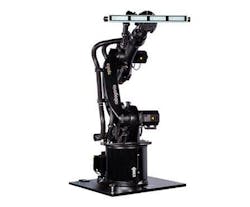Some people may not know that illumination and optical design software producer Lambda Research Corporation (Littleton, MA) is also the U.S. distributor of products from the Weingarten, Germany based optics company opsira, which makes optics and optical test equipment for illumination. The new products developed by opsira, in combination with the overlap in expertise between opsira and Lambda Research, can make for the introduction of some interesting new hardware.
One example of this is the latest introduction to the U.S. market by opsira via Lambda Research—the "robogonio," a robot-driven, multifunctional goniometer that incorporates six-axis measurement of angular-dependent photometric and radiometric parameters to combine the uses of different conventional goniometer types into one device. Lambda Research says it is the first of its kind.
The robogonio uses an industrial robot to provide flexibility in the positioning of light samples for measurements of light sources and luminaires. With a variety of mechanical variances, as well as the ability to manipulate measurement angles (with a repeatability of 0.005°), the robogonio goniometer can scan almost any geometry in the traditional A, B, or C planes by using a single measurement system, according to Lambda Research. This capability saves time and increases accuracy and productivity by eliminating the need to move test materials and recalibrate the unit.
The robot-based device has both near-field and far-field capabilities. So, for example, early in a project, a user might measure sources in the near field and use the software to derive ray data. Later, the robogonio would be used to measure the far-field luminous intensity pattern or plane illumination distribution. The resulting luminaire output can be generated in IES format for direct comparison with TracePro (Lambda Research illumination-design software) simulations or direct use with lighting-design software such as LiteStar 4D (OxyTech; Cornaredo, Italy), AGi32 (lighting Analysts; Littleton, CO), or DIALux (DIAL; Lüdenscheid, Germany).
A demo of the robiogonio can be found at opsira's YouTube channel at https://www.youtube.com/c/OpsiraDE.
Source: Lambda Research

